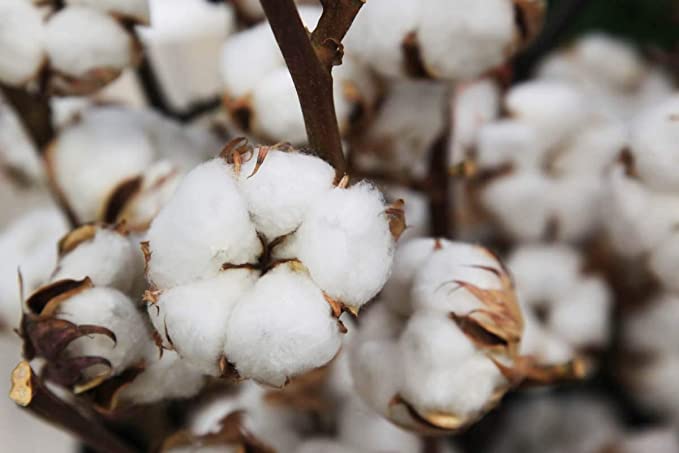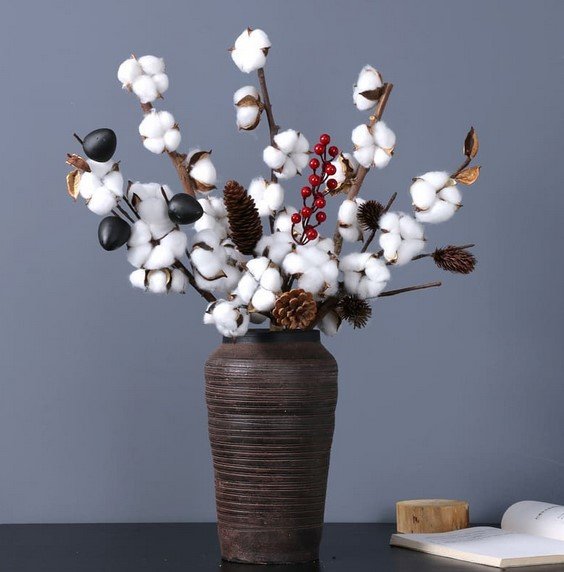Cotton flower specifications
- Scientific name : Gossypium
- Order : Malvales
- Family : Malvaceae
- Subfamily : Malvoideae
- Tribe : Gossypieae
- Genus : Gossypium
Cotton is the collective name given to four species of plants in the genus Gossypium, Gossypium hirsutum, Gossypium barbadense, Gossypium arboreum and Gossypium herbaceum which are perennial shrubs in the family Malvaceae grown for the fluffy fiber which protects the seeds of the plant
G. hirsutum accounts for approximately 90% of world wide cotton production today. Cotton plants possess a main stem giving rise to several branches at the top. The leaves of the plant are spirally arranged on the branches, have long petioles and have 3–5 triangular lobes. The plant produces a single flower on each axillary branch which can be red-purple, yellow or white in color and forms a leathery, oval seed capsule, or ‘boll’ which is 2–6 cm (0.8–2.4 in) long.
read more : Everything about wild oat plant : How to Plant & care for them

Mature bolls will usually split open to reveal the characteristic white cotton fibers and the seed. The cotton plant can reach heights of 1–1.5 m (3.3–4.9 ft) and is usually cultivated as an annual, surviving only one growing season. Cotton may also be referred to as tree cotton and its center of origin is unknown although the plant has diversified from Mexico, north-east Africa and Arabia and Australia.
The best areas for planting cotton
The best areas for keeping cotton flowers are warm and subtropical regions. Because most of the time the right temperature for these plants in these areas. Cities such as Jiroft, Khorasan, Ahvaz, Gorgan and Varamin are suitable cities for planting cotton flowers. Cotton harvest usually begins in July and may continue in November and will be ready for harvest in about 6 weeks.
Where Does Cotton Grow?
Cotton grows in nearly all tropical and subtropical regions around the world, including the U.S., China, India, Uzbekistan, Pakistan, Brazil, and Turkey.
In the United States, Texas is the largest cotton producer, and the South Plains region in the northern part of the state is the largest contiguous cotton-growing area in the world.
read more : Everything about wheat cluster : How to Plant & care for them
Types of cotton flowers
There are four commercially grown species of cotton, all domesticated in antiquity :
- Gossypium hirsutum – upland cotton, native to Central America, Mexico, the Caribbean and southern Florida (90% of world production)
- Gossypium barbadense – known as extra-long staple cotton, native to tropical South America (8% of world production)
- Gossypium arboreum – tree cotton, native to India and Pakistan (less than 2%)
- Gossypium herbaceum – Levant cotton, native to southern Africa and the Arabian Peninsula (less than 2%)
Hybrid varieties are also cultivated.[3] The two New World cotton species account for the vast majority of modern cotton production, but the two Old World species were widely used before the 1900s. While cotton fibers occur naturally in colors of white, brown, pink and green, fears of contaminating the genetics of white cotton have led many cotton-growing locations to ban the growing of colored cotton varieties.
Cotton propagation
Basic requirements Cotton is best grown in desert conditions using irrigation. The seeds will germinate optimally at 34°C (93.2°F), while the seedlings requires a temperature between 24 and 29°C (75.2–84.2°F) to grow and develop properly. Cotton will grow on a variety of soils including sandy soil and heavy clay as long as it is water permeable and will grow optimally in a soil with a pH of 5.5–8.5. In addition cotton has a high tolerance for salt.
Planting Cotton is propagated from seed by planting directly in a prepared field when growing conditions are favorable (suitable temperature, adequate rainfall etc). Cotton should only be planted when the soil has warmed to at least 18.3°C (65°F). Generally, seeds should be sown at a depth of 0.25 cm (1 in), with 3–6 seed sown in each hole. Ridging the soil is recommended as it helps to drain the plant in wet conditions and also to conserve water in dry conditions.
read more : Everything about pampas grass : How to Plant & care for them
Plant spacing depends on the variety but generally 20–100 cm (7.9–39.4 in) should be left between plants. General care and maintenance The cotton field should be kept free from weeds and where the crop does not receive an adequate amount of water from rainfall, additional irrigation should be provided. Demand for nutrients is dependent on the type of soil on which the cotton is being grown.
Cotton growing in acidic soils the plants will have a greater demand for nitrogen and phosphorus, whereas in sandy soil, potassium will be of greater importance. It is not recommended to grow cotton in the same field for more than three years and the crop should be rotated to prevent the build-up of diseases in the soil. Harvesting Cotton is still picked by hand in many areas of the world where the crop is grown. In the US cotton is machine harvested.
Cotton in ready to harvest approximately 4 months after sowing when the bolls split open to reveal the white cotton fibers. Fields are usually picked once every 3 to 4 weeks to prevent the fibers remaining in the field too long where they are susceptible to pests. The entire field is usually harvested with 2 to 3 pickings.
Top cotton exporting countries
- China
- United States of America
- India
- Pakistan
- Vietnam
- Turkey
- Australia
- Brazil
- Hong Kong
- Italy
- Germany
- Uzbekistan
- Indonesia
- Spain
- Thailand
read more : Everything about giant reed : How to Plant & care for them
Countries importing cotton flowers
- China
- Bangladesh
- Vietnam
- Turkey
- Indonesia
- Hong Kong
- South Korea
- Pakistan
- Italy
- Mexico
- Germany
- America
- Egypt
- Thailand
Iran dried cotton flower
-
Colorful cotton dried flowers
This dried cotton flower pods is one of the most stylish and beautiful decorative items that are placed inside gift boxes and multiplies the beauty of the gift. These pods are prepared and produced in different colors that you can choose and prepare any color that you like the most. In some packages, the color of the flowers is a single color, and in others, several colors that you can prepare any you want.

-
Dried cotton flower branches
In addition to their beauty, dried flowers are also very durable and can be stored for years without breaking or rotting over time. In addition to its beauty aspect, dried cotton flower has many usage in traditional medicine, pharmaceutical industry and so on.
This has led to many usage in the world. The reasonable price of dried cotton flowers has caused the exporters and wholesalers of dried cotton flowers to sell and buy dried cotton flowers for export. Cotton flower is one of Iran’s export goods and has provided a great opportunity for Iranian traders to bring a lot of currency to the country by exporting dried cotton flower.
read more : Drying natural flowers | Introducing 8 wonderful ways to dry flowers

Dried cotton flower
The situation of cotton cultivation in Iran
Due to the connection point between cotton agriculture and textile industry, Iran is one of the cotton producers in the world due to having several textile factories in different cities and their durability. Of course, cotton producers in the world are examined from two aspects, namely natural cotton production and industrial cotton production, among which natural cotton is more welcomed and used in the world.
Due to the reasonable price for buying and selling cotton flowers, exporters and wholesalers of cotton flowers have been able to obtain good currency by exporting natural cotton or dried cotton flowers to many requesting countries. Kuwait, Kazakhstan, Russia, India and Switzerland have the best destinations for cotton exports from Iran due to the extent of export potential and the ease of trade relations between the two countries .
Notice : this article has been translated by google translate , if you have any questions or need more information Please contact us by writing a comment on this page.



0 Comments